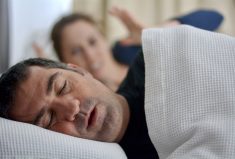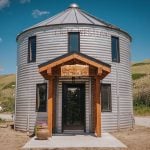Apnea is Greek in origin and means “not breathing.” Thus sleep apnea occurs during sleep. It is a breathing disorder that occurs as the result of the partial or complete blockage of the upper airway by soft tissue and muscle. This results in a lack of oxygen, which in turn causes the brain to arouse the body so that breathing can occur again.
Sleep apnea seems to be more common in recent times, but the increase may be due to improved diagnosing. It is estimated that about 24 per cent of older men are affected. It is less common among older women, about nine per cent.
Obesity is a risk factor just because being overweight means there is more tissue everywhere in the body including in the nose and throat. With obesity, the incidence increases to approximately 50 per cent of men and 40 per cent of women.
Read Also

Employment Agreements Can Help Protect Your Farm
Entering into employment agreements with each of your farm employees should be at the top of every farm’s “to do” list, but caution must be exercised.
The anatomy of the nose and throat can be the cause of sleep apnea. With a deviated septum the bone and cartilage that divides the nose into two halves is off-centre, meaning that there is not a direct path for breathing in air.
With age, as well, the throat and tongue muscles weaken, becoming “flabby,” again changing the route for inhaled air.
Snoring is the hallmark symptom of sleep apnea. Air doesn’t move freely through the upper respiratory tract during sleep, and the surrounding tissues vibrate resulting in classic snoring sounds. But, not all snoring is caused by sleep apnea.
Nasal congestion associated with a cold may plug the nose and cause snoring, and even excessive alcohol consumption can relax muscles resulting in snoring. Both, though, may only be temporary in nature.
Sometimes diseases are associated with an increased risk for sleep apnea, for example heart failure, stroke, atrial fibrillation, high blood pressure, diabetes, thyroid conditions. It is thought that a combination of factors accounts for this risk, including changes in muscle tissues as well as nervous system malfunction. With sleep apnea, too, oxygen supplies are low, which can have an adverse impact on these conditions.
Drugs with sedation as an adverse effect as well as chronic alcohol use can relax muscles and tissues resulting in sleep apnea. Smoking is associated with both sleep apnea and snoring, although the mechanism is not well understood. And, of course, sleeping position is important, specifically a supine or back position means gravity will allow tissues to block the respiratory tract.
Sleep apnea may just be bothersome especially for a bed partner who hears snoring, but in chronic conditions there can be daytime drowsiness, fatigue and insomnia. The treatment is an appliance that delivers air to keep airways open and there are numerous options available. These are positive airway pressure appliances; besides treating sleep apnea, they also are able to improve cardiovascular health because of an improved supply of oxygen. The downside of the appliances is discomfort, claustrophobia and dry mouth.
Oral devices are an option too. They reposition the mouth, tongue, and other mouth tissues. While not as effective as positive airway pressure appliances, the oral devices may be more comfortable and a suitable option when sleep apnea is not severe. Adhesive breathing strips are applied to the nose to open airways, and may also be an alternative, again when sleep apnea is not severe.
For sleep apnea, and even snoring, the first steps may be lifestyle modification, for example weight loss, exercise, smoking cessation, not sleeping in a supine position, avoiding alcohol and sedating drugs especially prior to sleep, and elevation of the head of the bed. Importantly, these measures are also excellent for your overall health!















